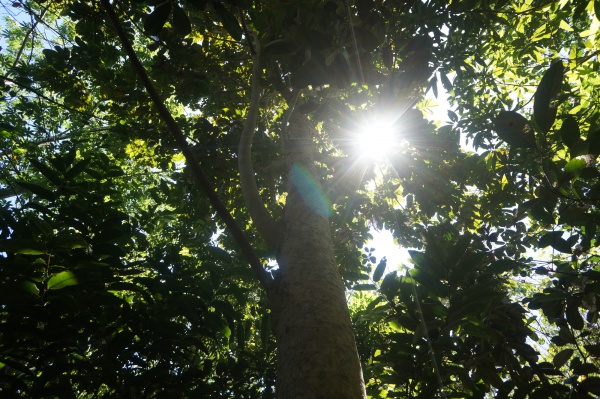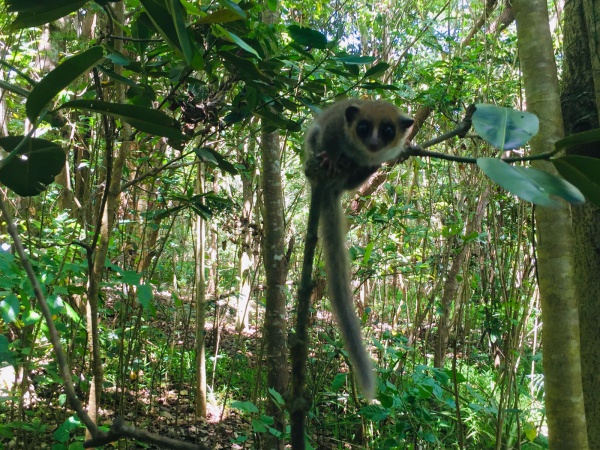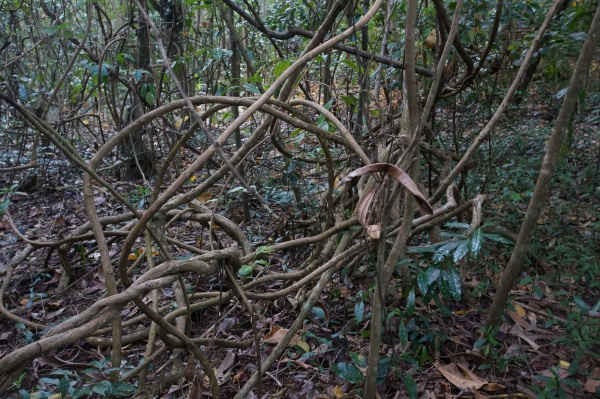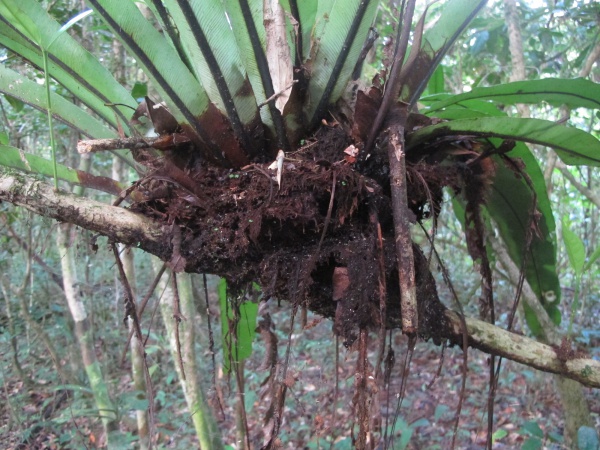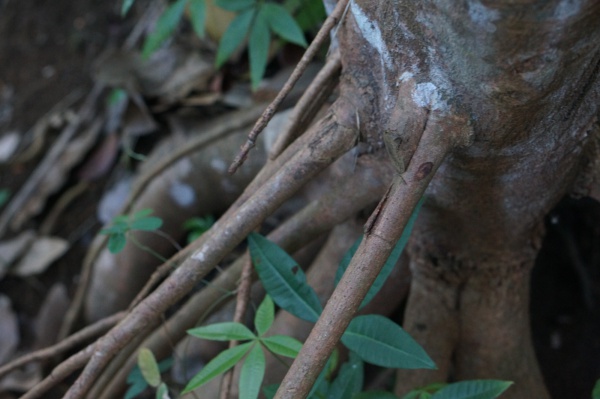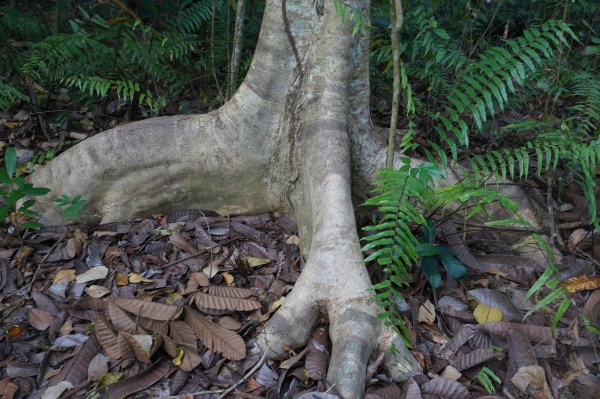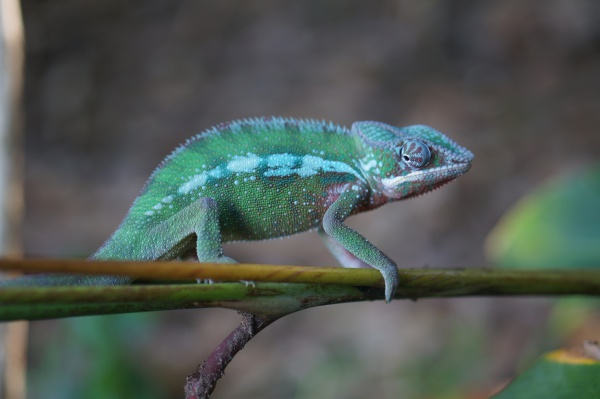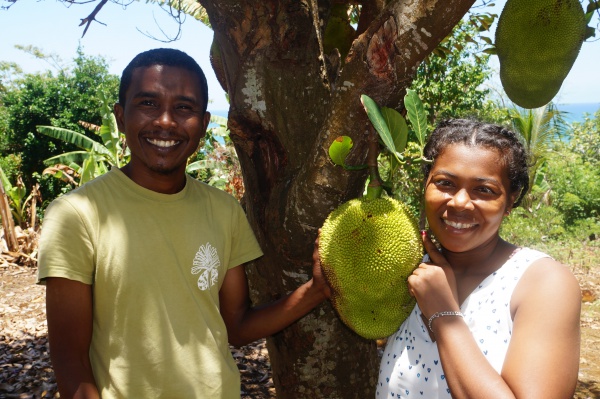Difference between revisions of "Macolline Forest"
CampMaster (talk | contribs) |
CampMaster (talk | contribs) |
||
| (19 intermediate revisions by the same user not shown) | |||
| Line 1: | Line 1: | ||
| − | '''Macolline is a botanical nature reserve 3km from the town centre of Antalaha. Also known as Ambinany, the | + | '''Macolline Forest is a botanical nature reserve 3km from the town centre of Antalaha. Also known as Ambinany, the area covers 10 hectares and has over 600 native and introduced precious and semi-precious species of plants and trees as well as a diverse fauna, including chameleons and lemurs.''' |
{| class="imageTable" | {| class="imageTable" | ||
|- | |- | ||
| − | |colspan="3" | [[File:Macolline | + | |colspan="3" | [[File:Macolline Forest 273.jpg|600px]] |
|- | |- | ||
| − | |[[File:Macolline | + | |[[File:Macolline Forest 280.jpg|196px]] |
| − | |align="center"|[[File:Macolline | + | |align="center"|[[File:Macolline Forest 276.jpg|196px]] |
| − | |align="right"|[[File:Macolline | + | |align="right"|[[File:Macolline Forest 278.jpg|196px]] |
|- | |- | ||
|} | |} | ||
| − | Macolline | + | Macolline Forest was founded by Marie Hélène Kam Hyo, a pharmacist in Antalaha. A species of the Clerodendrum family (Lamiaceae) was discovered by her here in 2002 and formally identified and named ''Clerodendrum kamhyoae'' in 2016. |
| − | While flowering usually begins in April and continues until July, a highlight can be observed at the peak of | + | While flowering usually begins in April and continues until July, a highlight can be observed at the peak of flowering in May when the trunk of each tree is draped in long elegant clusters of white flowers. Marie Hélène dubbed the plant "Lamariée" ("The Bride"). |
The Clerodendrum kamhyoa plant has been assigned a preliminary status of “Endangered” by IUCN Red List Categories and Criteria. Conservation efforts at Macolline have significantly lowered its risk of extinction. | The Clerodendrum kamhyoa plant has been assigned a preliminary status of “Endangered” by IUCN Red List Categories and Criteria. Conservation efforts at Macolline have significantly lowered its risk of extinction. | ||
| Line 19: | Line 19: | ||
{| class="imageTable" | {| class="imageTable" | ||
|- | |- | ||
| − | |colspan="3" | [[File:Macolline | + | |colspan="3" | [[File:Macolline Forest 142.jpg|600px]] |
|- | |- | ||
| − | |[[File:Macolline | + | |[[File:Macolline Forest 231.jpg|196px]] |
| − | |align="center"|[[File:Macolline | + | |align="center"|[[File:Macolline Forest 119.jpg|196px]] |
| − | |align="right"|[[File:Macolline | + | |align="right"|[[File:Macolline Forest 153.jpg|196px]] |
|- | |- | ||
|} | |} | ||
| − | + | In 2008 the forest area opened as a conservation site including an educational centre offering visitors the opportunity to learn and see the different botanical species along a well-maintained trail including beautiful views of the surrounding landscapes. | |
| − | Among the different species in the | + | ''Among the different species in the forest there are:'' |
Fast-growing woods are often used as firewood and in timber for construction of furniture. One such tree is [https://prota.prota4u.org/protav8.asp?g=pe&p=Intsia+bijuga Intsia] which can grow at a rate of one metre per year. | Fast-growing woods are often used as firewood and in timber for construction of furniture. One such tree is [https://prota.prota4u.org/protav8.asp?g=pe&p=Intsia+bijuga Intsia] which can grow at a rate of one metre per year. | ||
| − | [[File:Macolline | + | [[File:Macolline Forest 151.jpg|600px]] |
Slow-growing woods: These are hardwoods that take several decades to grow. They are precious woods because they have a high value and are used to build luxurious furniture. Precious woods include palisander, ebony and [https://en.wikipedia.org/wiki/Rosewood rosewood]. Macolline are collecting and distributing rosewood and palisander seeds and seedlings for replanting initiatives. | Slow-growing woods: These are hardwoods that take several decades to grow. They are precious woods because they have a high value and are used to build luxurious furniture. Precious woods include palisander, ebony and [https://en.wikipedia.org/wiki/Rosewood rosewood]. Macolline are collecting and distributing rosewood and palisander seeds and seedlings for replanting initiatives. | ||
| Line 41: | Line 41: | ||
Endemic species occur naturally without human intervention and when they only grow or live there. In Madagascar and Macolline endemic species include Ravenala madagascariensis, Clerodendrum kamhyoae, Bamboo lemur and Mouse lemur. | Endemic species occur naturally without human intervention and when they only grow or live there. In Madagascar and Macolline endemic species include Ravenala madagascariensis, Clerodendrum kamhyoae, Bamboo lemur and Mouse lemur. | ||
| − | [[File:Macolline | + | [[File:Macolline Forest 281.jpg|600px]] |
The exotic species: A species introduced (planted) in a country that is not its country of origin, it is said to be exotic. Some exotic species become very invasive and prevent native plants from reproducing. | The exotic species: A species introduced (planted) in a country that is not its country of origin, it is said to be exotic. Some exotic species become very invasive and prevent native plants from reproducing. | ||
| − | [[File:Macolline | + | [[File:Macolline Forest 220.jpg|600px]] |
Lianas: In tropical forests including Macolline, lianas are abundant. They climb along tree trunks or remain free and hanging from branches making it difficult to spot the beginning or the end. Lianas are terrestrial plants that seek light. Liana is a name given to all types of terrestrial or epiphytic climbing plants, capable of clinging to a support. <!-- examples include at Macolline include --> | Lianas: In tropical forests including Macolline, lianas are abundant. They climb along tree trunks or remain free and hanging from branches making it difficult to spot the beginning or the end. Lianas are terrestrial plants that seek light. Liana is a name given to all types of terrestrial or epiphytic climbing plants, capable of clinging to a support. <!-- examples include at Macolline include --> | ||
| Line 55: | Line 55: | ||
Two distinct types of root formations that can be seen in the Macolline forest are ''stilt roots'' and ''foothill roots''. | Two distinct types of root formations that can be seen in the Macolline forest are ''stilt roots'' and ''foothill roots''. | ||
| − | [[File:Macolline | + | [[File:Macolline Forest 013.jpg|600px]] |
Stilt roots are produced by the trunk or branches and develop in the open air before penetrating the ground. This adaptation allows a better base and elevation above the water (competition for space). In the undergrowth, some trees grow by extending their roots towards the brightest areas (competition for light). | Stilt roots are produced by the trunk or branches and develop in the open air before penetrating the ground. This adaptation allows a better base and elevation above the water (competition for space). In the undergrowth, some trees grow by extending their roots towards the brightest areas (competition for light). | ||
| − | [[File: | + | [[File:Macolline_Forest_225.jpg|600px]] |
Foothill roots are vertically flattened root expansions, glued to the trunk. Depending on the size and age of the tree, the buttresses can be numerous, reach several meters high and branch out. They allow better fixation and resistance to wind. | Foothill roots are vertically flattened root expansions, glued to the trunk. Depending on the size and age of the tree, the buttresses can be numerous, reach several meters high and branch out. They allow better fixation and resistance to wind. | ||
| Line 93: | Line 93: | ||
{| class="imageTable" | {| class="imageTable" | ||
|- | |- | ||
| − | |colspan="3" | [[File:Macolline | + | |colspan="3" | [[File:Macolline Forest 009.jpg|600px]] |
|- | |- | ||
| − | |[[File:Macolline | + | |[[File:Macolline Forest 006.jpg|196px]] |
| − | |align="center"|[[File:Macolline | + | |align="center"|[[File:Macolline Forest 005.jpg|196px]] |
| − | |align="right"|[[File:Macolline | + | |align="right"|[[File:Macolline Forest 011.jpg|196px]] |
|- | |- | ||
|} | |} | ||
| Line 108: | Line 108: | ||
<HTML5video type="youtube">bMg2gpzVdwM</HTML5video> | <HTML5video type="youtube">bMg2gpzVdwM</HTML5video> | ||
| + | |||
| + | <HTML5video type="youtube">I9WjJn3ksAo</HTML5video> | ||
| + | |||
| + | <HTML5video type="youtube">E5W5i-y3DP8</HTML5video> | ||
| + | |||
| + | <HTML5video type="youtube">voBOpXOASK0</HTML5video> | ||
| + | |||
| + | <HTML5video type="youtube">hQV8UDDdTOE</HTML5video> | ||
A knowledgeable guide explains the different species and their uses in traditional Malagasy medicine and culture. | A knowledgeable guide explains the different species and their uses in traditional Malagasy medicine and culture. | ||
| Line 113: | Line 121: | ||
{| class="imageTable" | {| class="imageTable" | ||
|- | |- | ||
| − | |colspan="3" | [[File:Macolline | + | |colspan="3" | [[File:Macolline Forest 167.jpg|600px]] |
|- | |- | ||
| − | |[[File:Macolline | + | |[[File:Macolline Forest 169.jpg|196px]] |
| − | |align="center"|[[File:Macolline | + | |align="center"|[[File:Macolline Forest 175.jpg|196px]] |
| − | |align="right"|[[File:Macolline | + | |align="right"|[[File:Macolline Forest 160.jpg|196px]] |
|- | |- | ||
| − | |[[File:Macolline | + | |[[File:Macolline Forest 173.jpg|196px]] |
| − | |align="center"|[[File:Macolline | + | |align="center"|[[File:Macolline Forest 172.jpg|196px]] |
| − | |align="right"|[[File:Macolline | + | |align="right"|[[File:Macolline Forest 170.jpg|196px]] |
|- | |- | ||
|} | |} | ||
| − | A canoe ride | + | A canoe ride offers visitors a tour of a traditional brick-making facility along the river behind the forest. |
| − | [[File:Macolline | + | [[File:Macolline Forest 037.jpg|600px]] |
It is difficult not to spot chameleons when visiting Macolline. Species of chameleons found in the park include Panther chameleon (Furcifer pardalis) and Madagascar pimple-nose chameleon (Calumma nasutum). | It is difficult not to spot chameleons when visiting Macolline. Species of chameleons found in the park include Panther chameleon (Furcifer pardalis) and Madagascar pimple-nose chameleon (Calumma nasutum). | ||
| Line 133: | Line 141: | ||
{| class="imageTable" | {| class="imageTable" | ||
|- | |- | ||
| − | |colspan="3" | [[File:Macolline | + | |colspan="3" | [[File:Macolline Forest 145.jpg|600px]] |
|- | |- | ||
| − | |[[File:Macolline | + | |[[File:Macolline Forest 081.jpg|196px]] |
| − | |align="center"|[[File:Macolline | + | |align="center"|[[File:Macolline Forest 029.jpg|196px]] |
| − | |align="right"|[[File:Macolline | + | |align="right"|[[File:Macolline Forest 115.jpg|196px]] |
|- | |- | ||
|} | |} | ||
| Line 145: | Line 153: | ||
{| class="imageTable" | {| class="imageTable" | ||
|- | |- | ||
| − | |colspan="3" | [[File:Macolline | + | |colspan="3" | [[File:Macolline Forest 261.jpg|600px]] |
|- | |- | ||
| − | |[[File:Macolline | + | |[[File:Macolline Forest 248.jpg|196px]] |
| − | |align="center"|[[File:Macolline | + | |align="center"|[[File:Macolline Forest 249.jpg|196px]] |
| − | |align="right"|[[File:Macolline | + | |align="right"|[[File:Macolline Forest 246.jpg|196px]] |
|- | |- | ||
|} | |} | ||
| Line 157: | Line 165: | ||
{| class="imageTable" | {| class="imageTable" | ||
|- | |- | ||
| − | |colspan="3" | [[File:Macolline | + | |colspan="3" | [[File:Macolline Forest 193.jpg|600px]] |
|- | |- | ||
| − | |[[File:Macolline | + | |[[File:Macolline Forest 200.jpg|196px]] |
| − | |align="center"|[[File:Macolline | + | |align="center"|[[File:Macolline Forest 196.jpg|196px]] |
| − | |align="right"|[[File:Macolline | + | |align="right"|[[File:Macolline Forest 195.jpg|196px]] |
|- | |- | ||
| − | |[[File:Macolline | + | |[[File:Macolline Forest 186.jpg|196px]] |
| − | |align="center"|[[File:Macolline | + | |align="center"|[[File:Macolline Forest 188.jpg|196px]] |
| − | |align="right"|[[File:Macolline | + | |align="right"|[[File:Macolline Forest 181.jpg|196px]] |
|- | |- | ||
|} | |} | ||
| Line 171: | Line 179: | ||
<div style="max-width:600px;"> | <div style="max-width:600px;"> | ||
{{#display_map: | {{#display_map: | ||
| − | -14.871818478797703,50.261602178689564~Macolline | + | -14.871818478797703,50.261602178689564~Macolline Forest entrance and educational centre~~; |
| − | -14.872874097819007,50.26059125591863~Macolline | + | -14.872874097819007,50.26059125591863~Macolline Forest~~; |
-14.877120943062161,50.257971643976106~Brick-making~~; | -14.877120943062161,50.257971643976106~Brick-making~~; | ||
|type=satellite | |type=satellite | ||
| Line 184: | Line 192: | ||
</div> | </div> | ||
| − | The | + | The forest is open to visitors every day. An information centre and various locally handcrafted souvenirs are for sale at the entrance. For guided tours and group reservations, contact Ertice and Lilyane at +261 32 89 358 26 / +261 32 55 214 08 (WhatsApp) or by email [mailto:marielilyane@gmail.com marielilyane@gmail.com] / [mailto:yarozafy@gmail.com yarozafy@gmail.com] |
| − | [[File: | + | [[File:Macolline_Forest_287.jpg|600px]] |
| − | '''Macolline | + | '''Macolline Forest'''<br> |
206, Antalaha<br> | 206, Antalaha<br> | ||
Madagascar | Madagascar | ||
| Line 195: | Line 203: | ||
Email: [mailto:macolline.madagascar@gmail.com macolline.madagascar@gmail.com] | Email: [mailto:macolline.madagascar@gmail.com macolline.madagascar@gmail.com] | ||
| − | View all [[Macolline | + | View all [[Macolline Forest photos]] |
== Further information == | == Further information == | ||
| − | * https://www.macolline.org | + | * Macolline homepage: [https://www.macolline.org Macolline.org] |
| − | * [[ | + | * [https://www.youtube.com/watch?v=WtIk09pDB9g TV broadcast on Zone Australe/Antenne Réunion] |
| − | * https://www.youtube.com/ | + | * [https://www.youtube.com/playlist?list=PL2PUMu_dznna5UmcmY42_nDhI8ADxNNMO Macolline YouTube videos by Ertice Iarozafy] |
| − | * https://www.researchgate.net/figure/Line-drawings-of-Clerodendrum-kamhyoae-Phillipson-Allorge-A-Leaf-showing-long_fig1_301740386 | + | * [https://www.youtube.com/playlist?list=PL2PUMu_dznnaaqJCXeOvdVNyBozVvKWQA Macolline YouTube Shorts by Ertice Iarozafy] |
| − | * https:// | + | * [[Media:Philipson_Clerodendrum.pdf|Philipson_Clerodendrum.pdf]] |
| − | * [[:File:Indigenous_fruit_trees_of_Madagascar_Potential_com.pdf]] | + | * [https://www.researchgate.net/figure/Line-drawings-of-Clerodendrum-kamhyoae-Phillipson-Allorge-A-Leaf-showing-long_fig1_301740386 Line drawings of Clerodendrum kamhyoae on ResearchGate.net] |
| − | * [[:File:The-Red-List-of-Trees-of-Madagascar.pdf]] | + | * [https://www.wikidata.org/wiki/Q55231410 Clerodendrum kamhyoae entry on wikidata.org] |
| − | + | * [[:File:Indigenous_fruit_trees_of_Madagascar_Potential_com.pdf|Indigenous_fruit_trees_of_Madagascar_Potential_com.pdf]] | |
| + | * [[:File:The-Red-List-of-Trees-of-Madagascar.pdf|The-Red-List-of-Trees-of-Madagascar.pdf]] | ||
<!-- removed | <!-- removed | ||
Latest revision as of 12:22, 3 April 2025
Macolline Forest is a botanical nature reserve 3km from the town centre of Antalaha. Also known as Ambinany, the area covers 10 hectares and has over 600 native and introduced precious and semi-precious species of plants and trees as well as a diverse fauna, including chameleons and lemurs.
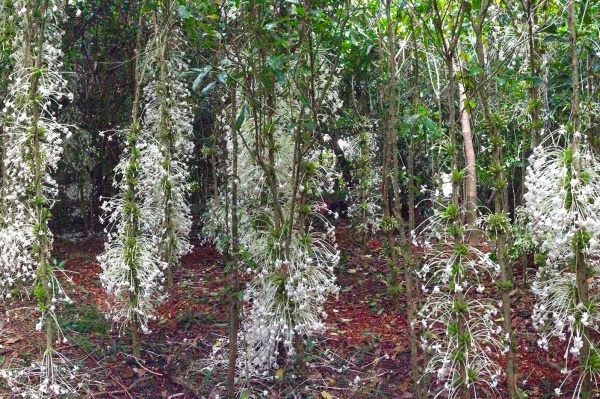
| ||

|

|
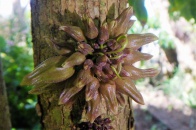
|
Macolline Forest was founded by Marie Hélène Kam Hyo, a pharmacist in Antalaha. A species of the Clerodendrum family (Lamiaceae) was discovered by her here in 2002 and formally identified and named Clerodendrum kamhyoae in 2016.
While flowering usually begins in April and continues until July, a highlight can be observed at the peak of flowering in May when the trunk of each tree is draped in long elegant clusters of white flowers. Marie Hélène dubbed the plant "Lamariée" ("The Bride").
The Clerodendrum kamhyoa plant has been assigned a preliminary status of “Endangered” by IUCN Red List Categories and Criteria. Conservation efforts at Macolline have significantly lowered its risk of extinction.

| ||
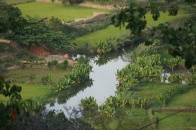
|
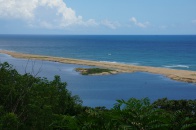
|
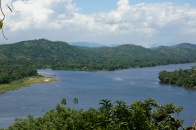
|
In 2008 the forest area opened as a conservation site including an educational centre offering visitors the opportunity to learn and see the different botanical species along a well-maintained trail including beautiful views of the surrounding landscapes.
Among the different species in the forest there are:
Fast-growing woods are often used as firewood and in timber for construction of furniture. One such tree is Intsia which can grow at a rate of one metre per year.
Slow-growing woods: These are hardwoods that take several decades to grow. They are precious woods because they have a high value and are used to build luxurious furniture. Precious woods include palisander, ebony and rosewood. Macolline are collecting and distributing rosewood and palisander seeds and seedlings for replanting initiatives.
Native species: We speak of an indigenous native species when the plant is native to the country in which it is observed but its distribution area does not stop only in this country. That is to say, it can exist naturally in other regions of the planet. For example, one native species at Macolline is Canarium madagascariense which apart from Madagascar, occurs naturally in Mozambique and Tanzania.
Endemic species occur naturally without human intervention and when they only grow or live there. In Madagascar and Macolline endemic species include Ravenala madagascariensis, Clerodendrum kamhyoae, Bamboo lemur and Mouse lemur.
The exotic species: A species introduced (planted) in a country that is not its country of origin, it is said to be exotic. Some exotic species become very invasive and prevent native plants from reproducing.
Lianas: In tropical forests including Macolline, lianas are abundant. They climb along tree trunks or remain free and hanging from branches making it difficult to spot the beginning or the end. Lianas are terrestrial plants that seek light. Liana is a name given to all types of terrestrial or epiphytic climbing plants, capable of clinging to a support.
Epiphytes: These are aerial plants that use other plants as support without being parasitic on their host. As they grow, epiphytes seek more light. It is rainwater or dew that waters them or runs off their support. As for nutrients, they are provided by the humus fixed on the tree. Many epiphytes are orchids, ferns and philodendrons.
Two distinct types of root formations that can be seen in the Macolline forest are stilt roots and foothill roots.
Stilt roots are produced by the trunk or branches and develop in the open air before penetrating the ground. This adaptation allows a better base and elevation above the water (competition for space). In the undergrowth, some trees grow by extending their roots towards the brightest areas (competition for light).
Foothill roots are vertically flattened root expansions, glued to the trunk. Depending on the size and age of the tree, the buttresses can be numerous, reach several meters high and branch out. They allow better fixation and resistance to wind.
Along the Macolline trail, visitors can expect to see:
1. Coffee tree - Coffea arabica
2. Litchi - Litchi sinensis
5. Mango tree – Mangifera indica & Asplenium nidus (bird’s nest fern)
6. Uapaca sp.
7. Pandanus sp.
10. Phyllarthron antongilensis
11. Jackfruit – Artocarpus heterophyllus
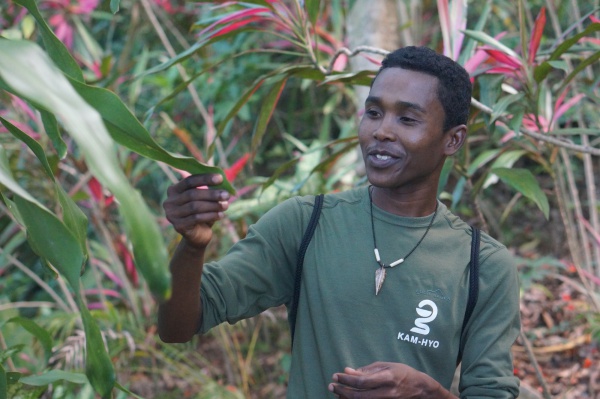
| ||
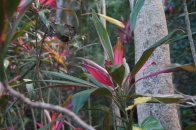
|
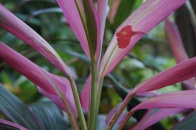
|
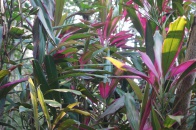
|
A knowledgeable guide explains the different species and their uses in traditional Malagasy medicine and culture.
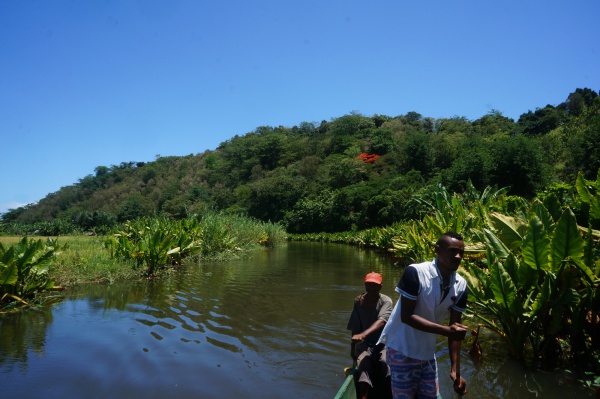
| ||
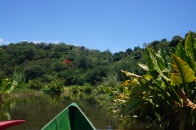
|

|

|
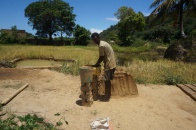
|
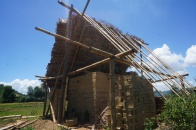
|
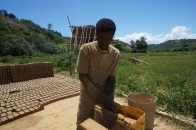
|
A canoe ride offers visitors a tour of a traditional brick-making facility along the river behind the forest.
It is difficult not to spot chameleons when visiting Macolline. Species of chameleons found in the park include Panther chameleon (Furcifer pardalis) and Madagascar pimple-nose chameleon (Calumma nasutum).
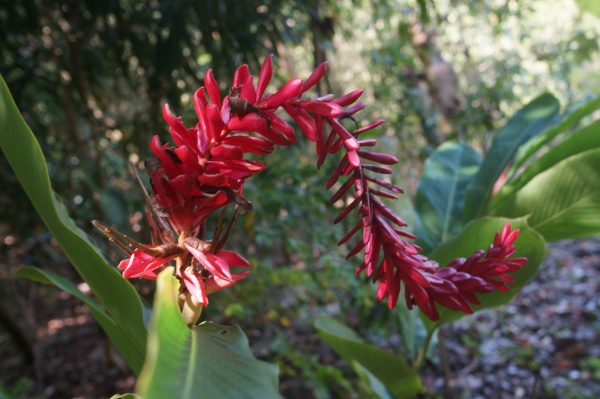
| ||
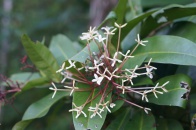
|
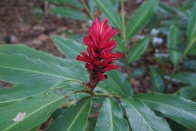
|
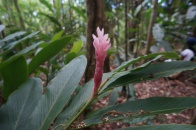
|
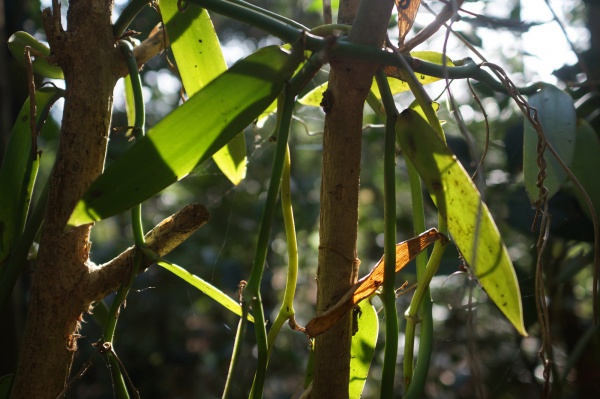
| ||
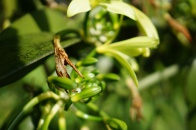
|

|
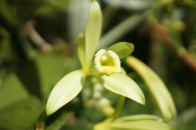
|
Among the introduced non-invasive species is the Vanilla planifolia orchid, which can be seen flowering between September and November. Each flower blossoms for only one day each year and does not produce vanilla beans unless it is pollinated by hand. The best time to see the orchids is in the early morning hours.
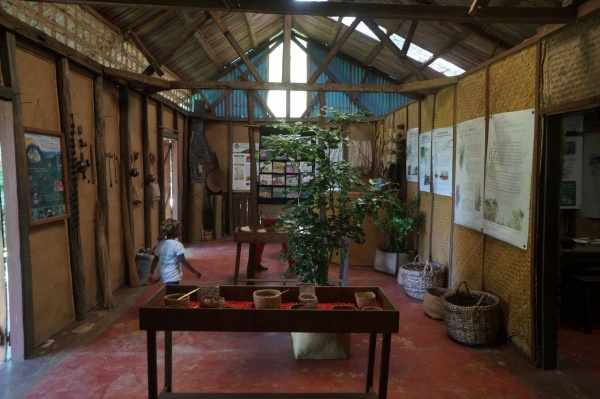
| ||
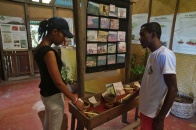
|
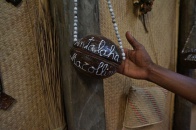
|
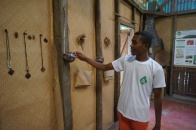
|
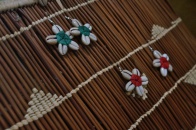
|
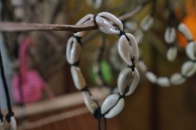
|
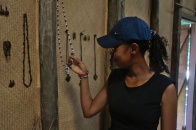
|
The forest is open to visitors every day. An information centre and various locally handcrafted souvenirs are for sale at the entrance. For guided tours and group reservations, contact Ertice and Lilyane at +261 32 89 358 26 / +261 32 55 214 08 (WhatsApp) or by email marielilyane@gmail.com / yarozafy@gmail.com
Macolline Forest
206, Antalaha
Madagascar
Tel: +261 (0)32 07 161 01 / +261 (0)32 55 127 71
Email: macolline.madagascar@gmail.com
View all Macolline Forest photos
Further information
- Macolline homepage: Macolline.org
- TV broadcast on Zone Australe/Antenne Réunion
- Macolline YouTube videos by Ertice Iarozafy
- Macolline YouTube Shorts by Ertice Iarozafy
- Philipson_Clerodendrum.pdf
- Line drawings of Clerodendrum kamhyoae on ResearchGate.net
- Clerodendrum kamhyoae entry on wikidata.org
- Indigenous_fruit_trees_of_Madagascar_Potential_com.pdf
- The-Red-List-of-Trees-of-Madagascar.pdf
